Wednesday, June 13, 2018
Madrid:
An easy passage past security and customs at the Madrid airport is a good start to our visit. The city is well connected via public transport, so the €30 cab ride to the hotel ends up being on the expensive side.
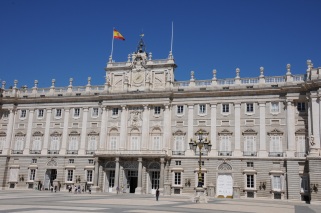
Madrid – Royal Palace
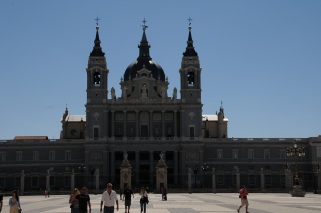
Almudena Cathedral
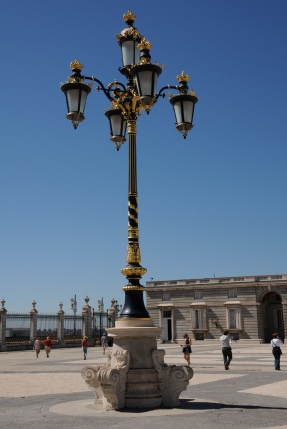
Royal Palace – gilded lamppost
After a piping hot breakfast, we’re off to the Royal Palace of Madrid – it’s within walkable distance and covers an imposing 135,000 sq. meters across 3,418 rooms. The gilded lampposts in the verandah show the opulence of the Spanish royalty. Our guide tells us that this is the biggest palace in Europe, but the Hofburg Palace in Austria is bigger at 240,000 sq. meters. The Royal family occupies the palace on special occasions – the current princess stayed at the palace to drive over to the nearby Almudena Cathedral for her wedding.
The Sabatini Gardens adjoin the rear end of the palace – the gardens are lush green and dotted with statues of Spanish kings. The adjoining Plaza de Orient garden has even more statues of kings.
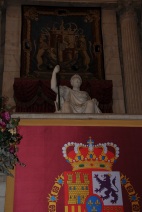
Charles IV statue
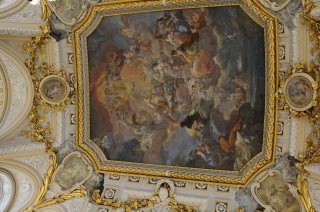
Royal Palace – ceiling fresco
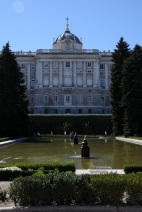
Royal Palace – view from Sabatini Gardens
The interior of the palace is notable for its wealth of art and the use of many types of fine materials in the construction and the decoration of its rooms. These include paintings and frescoes by Giovanni. The Grand Staircase at the entrance is composed of a single piece of San Agustin marble. Two lions grace the landing. On the ground floor is a statue of Charles III in Roman toga, with a similar statue on the first floor depicting Charles IV. The four cartouches at the corners depict the elements of water, earth, air and fire. Other collections of great historical and artistic importance preserved in the building include the Royal Armory of Madrid, porcelain, watches, furniture, silverware, and the world’s only complete Stradivarius string quintet.
In the evening, we treat ourselves to a round of tapas – tapas abound everywhere and actually are free – we just pay for the drinks. Post tapas, we stop by Gino’s – an Italian restaurant, for salad. They start us up with fresh tomato bread – fresh tomato, grated over bread – you can taste the freshness of the tomato and the bread. The caprese salad does not disappoint at all, when it comes to taste and freshness! Fresh ingredients in the cuisine will be the hallmark of our stay in Spain.
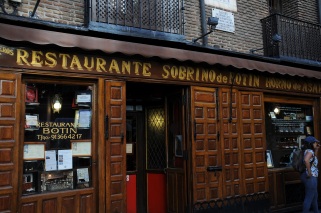
Botin Restaurant
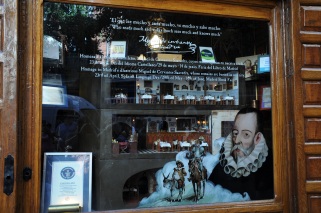
Botin Window – homage to Cervantes
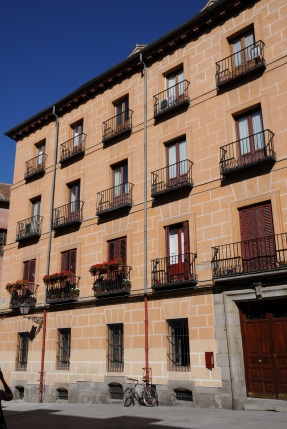
Madrid – balconies
Plaza Mayor is the right spot to start a walking tour of the downtown area of Madrid City. Plaza Mayor, with over 200 balconies is Madrid’s main square and fills up with locals and tourists for dinner and drinks. As we walk through the alleys, we come across the oldest restaurant in the world – Sobrino de Botín, founded in 1725 – the restaurant is mentioned in Ernest Hemingway’s ‘The Sun Also Rises.’ We are told that occasionally even the King dines here. Through the inner streets of Madrid, the elegant and varied colors on buildings, stand out.
In the evening, we decide to walk our way through Calle Gran Via to the San Anton Market. Gran Villa is busy, vibrant and buzzing with crowds. It is the place to shop and enjoy international stores in Madrid. The dogs are not on leash – but they are so well trained, they hardly stray from their tracks. From Gran Villa, we make our way into narrow streets dotted with some excellent food joint and bakeries – the Coca de Cristal at one of the bakeries awakens our taste buds.
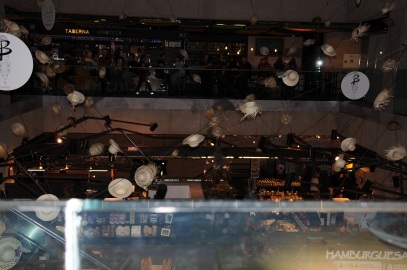
Anton Market
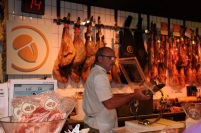
Anton Mkt – carving bacon
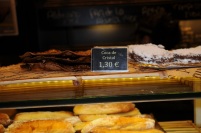
Coca de Cristal
The Anton Market is spread across 2 floors – fresh fruit, vegetables and meat on the 1st floor and eating joints on the 2nd floor. Freshness is key here and when I say fresh meat, the bacon is carved from the pig, right in front of you – its sheer artistry. We order the lentil salad and plantain fritters – the taste is divine!
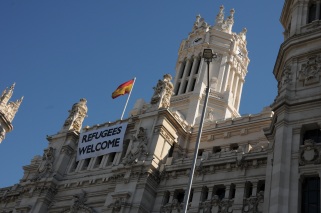
City Hall – Refugees Welcome sign
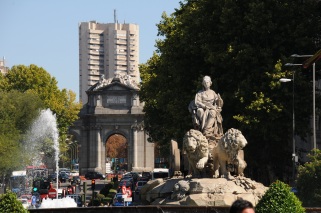
Cibeles Fountain
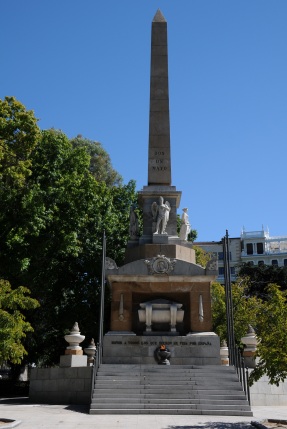
Obelisco del dos de Mayo
The next morning, we take the metro to the Atocha Train station – we are taking the Eurail to Barcelona. We dump our luggage in the cloak room and spend some time at the Plaza de Cibeles. A huge sign “Refugees Welcome” greets us as we look up the City Hall. At the center of the plaza is the Cibeles Fountain – it shows Cybele, the Greek goddess of fertility and nature holding a sceptre and a key while being pulled by two lions on a chariot. Notable sights along the Paseo Del Prado include the Obelisco del dos de Mayo – a monument to the heroes of Spain and the Botanical Garden.
Barcelona:
From the Atocha station, we are off to Barcelona – a 3 hour ride through open plains and a bright Sun. Barcelona appears more upbeat than Madrid. We pick a nearby restaurant, Patron for a round of seafood Paella – it’s a wait, but the Paella is delicious
The following morning, after a hot breakfast of croissants and eggs, we decide to walk our way through downtown Barcelona. It’s early morning and street cleaning seems to be the focus – as trucks pick up garbage, a few workers alight and ensure the streets are clean. Our walk starts at Avenue Diagonal – yes this street runs diagonally across Barcelona and is lined with stores and restaurants on both sides. The streets are wide and leave ample room for stops for local buses.
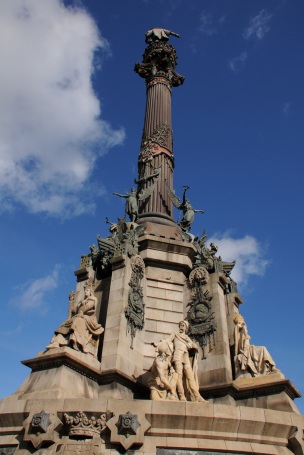
Columbus Monument
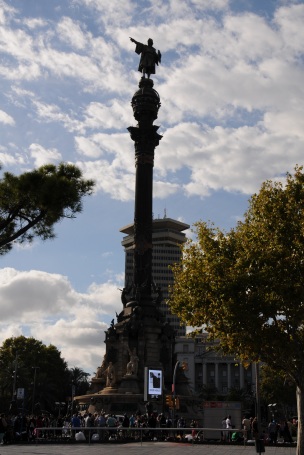
Columbus Monument
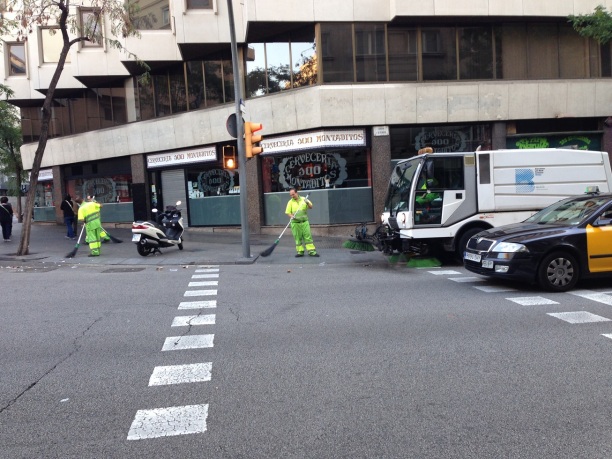
Barcelgona – street cleanin
We saunter our way towards the sea – the Mediterranean Sea and chance upon a 60m tall monument – the Columbus Monument. It was built in 1888 to commemorate Columbus’ first voyage to the Americas. At the very top of the monument stands a 7.2 m (24 ft) tall bronze statue of Columbus pointing towards the New World with his right hand.
We cross over to the overbridge to get over to the Moll d’Espanya – it’s dotted with shops and restaurants overlooking the Mediterranean Sea. The view of the sea invigorates us and we walk our way back to Las Ramblas – the street performers add to the color – this place is buzzing with energy and excitement. We follow the crowd into the Sant Joseph market. The market is a huge collection of stalls – everything is available – fish, fruits, vegetables, baked goods, condiments – it’s irresistible.
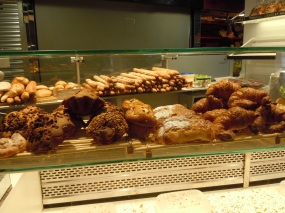
Bakery – Sant Joseph Market
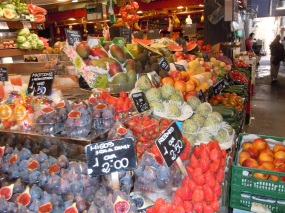
Sant Joseph Market
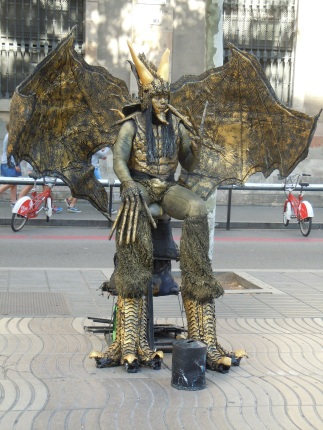
Street Performer
Barcelona is the home to the soccer club, FC Barcelona – so a visit to Camp Nou is mandatory – the soccer field is immaculately maintained, but it is the museum that steals the show – currently, it is a shrine to FC Barcelona’s super star – Lionel Messi. Superstars from yesteryears – Johan Cruyff, Romario, Luis Suarez, adorn the walls of the museum, so do a host of championship trophies – definitely worth a visit!
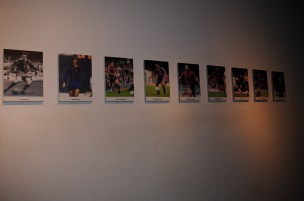
Camp Nou – the museum
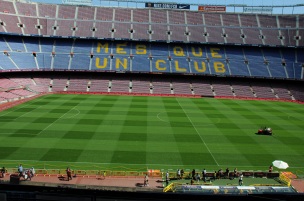
Camp Nou
Barcelona seems to love modernist buildings – you can see several of these along Passeig de Garcia – Casa Batllo, especially at night, stops you in your tracks. Designed by Antoni Gaudi, Casa Batlló looks like it has been made from skulls and bones. The “Skulls” are in fact balconies and the “bones” are supporting pillars.
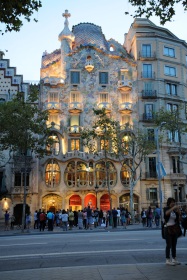
Casa Batllo
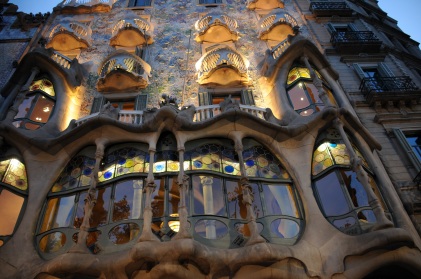
Casa Batllo – up close
Cerveceria Catalana – a premier tapas restaurant beckons after a long evening walk through Passeig de Garcia – an hour long wait is worth it – the food is unique, authentic and delicious.
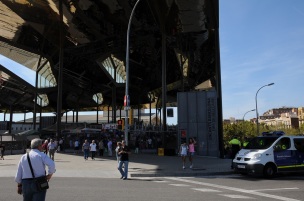
Encants – Flea market
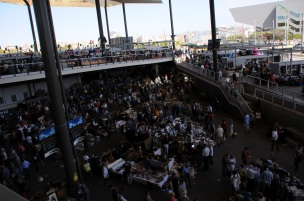
Encants – Flea market
Encants Barcelona is Barcelona’s biggest flea market – it is 2 levels huge and sells junk like rusty bikes and gems like antiques, furniture and books. My wife is looking for antiques – she is not disappointed – she picks up a display plate and a ceramic/bronze fruit bowl.
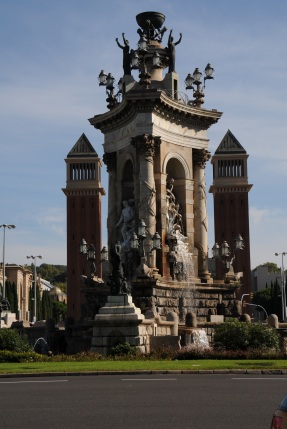
Plaza Espanya Fuente – flanked by Venetian Towers
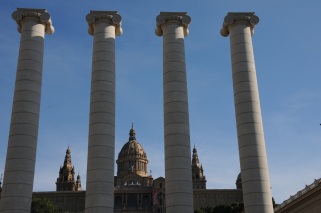
4 Columns overlooking the National Art Museum
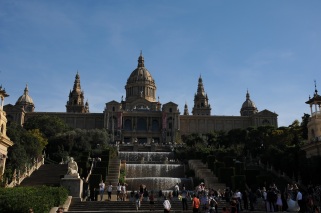
Museu Nacional d’Art de Catalunya
Plaza de Espanaya is the busiest and most important square in Barcelona. Once you land at the Plaza, you need to decide how you will see all that’s worth seeing – from the Venetian towers to the Museu Nacional d’Art de Catalunya. We make our way towards the Art Museum, walking past the Venetian Towers, the 4 columns and the Magic Fountain. The 4 columns were originally erected in 1919 – they symbolized the four stripes of the Catalan senyera, and they were intended to become one of the main icons of Catalanism. They were demolished in 1928 during Primo de Rivera’s dictatorship, but were subsequently rebuilt in 2010, not quite to the original design, which used then fashionable brick, rather than concrete. The two 47m high red-brick Venetian Towers were inspired by the bell-tower of St Mark’s Basilica in Venice. The towers are topped by large viewing galleries but unfortunately they are not currently open to the public. The Art Museum is one of the grandest art museums I have come across – covering 540,000 sq. ft, it exhibits Romanesque art, Gothic art, Renaissance and Baroque art, and modern art. You need a good 3 hours to enjoy and absorb the amazing art on display. The view from the top is panoramic – one can see the Basilica of the Sagrada Família – the most amazing and most frequented landmark in Barcelona – it is still under construction. We leave the museum close to its closing time and witness a concert in progress opposite the museum – the view of the plaza, from the museum is vibrant and enthralling.
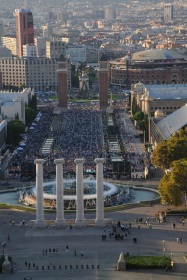
Plaza Espanya – concert
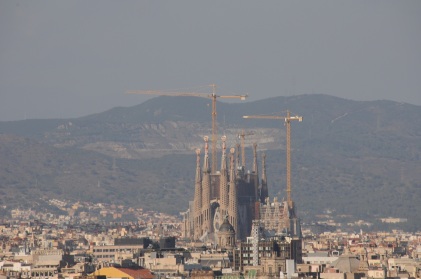
Basilica of the Sagrada Família
We are completely in love with Barcelona as we make our way to the airport, the next day – move here after retirement? A definite possibility!